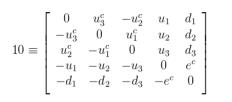For example, in this paper on page 21 the authors write the vev that breaks SO(10) to SU(4)×SU(2)×SU(2)
<54>=1/5⋅diag(−2,−2,−2,−2,−2,−2,3,3,3,3)ωs
where ωs denotes the scale.
What do the authors mean by this?
The Higgs field or Higgs fields that develop a vev are elements of the 54 representation of SO(10). Because 10⊗10=1s⊕54s⊕45a, we can write each element of 54 as a 10×10 matrix.
This is similar how one determines the particle content of the 10 representation of SU(5), written as 5×5 matrix, by using 5⊗5=10⊕….
The quantum numbers of the 10 inedpendent fields ∈ 10 are given by
QN(10ij)=QN(5i)+QN(5j),
where
10ij denotes the
ij element of the
5×5 matrix.
This yields

Completely equivalently we can determine the quantum numbers of the Higgs fields in the 54 representation of S0(10) and write them in a 10×10 matrix.
How does <54>=1/5⋅diag(−2,−2,−2,−2,−2,−2,3,3,3,3)ωs tell me which of these 54 Higgs fields gets a vev?
For concreteness let's consider a simplified setup. A computation similar to QN(10ij)=QN(5i)+QN(5j),, which yields for example the 10 of SU(5) as quoted above, yields a matrix for the Higgs bosons. For example, in a 2×2 case: (ABCD), where $A,B,C,D$ denote four different Higgs fields. Now given a vev = diag(1,−1)w, does this mean the Higgs field A gets a vev w and the Higgs field D gets a vev −w, while C and D do not get a vev?
 Q&A (4904)
Q&A (4904) Reviews (206)
Reviews (206) Meta (439)
Meta (439) Q&A (4904)
Q&A (4904) Reviews (206)
Reviews (206) Meta (439)
Meta (439)